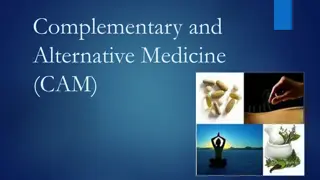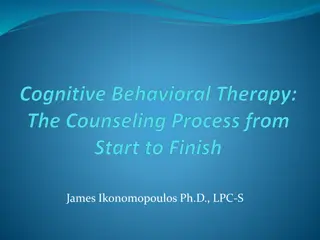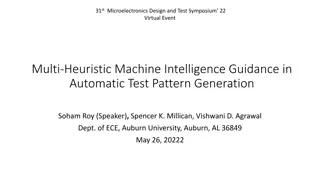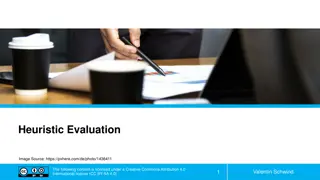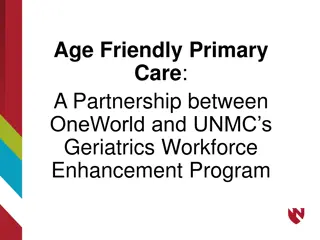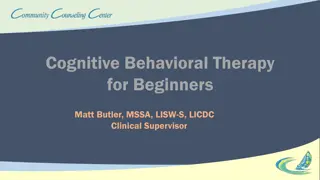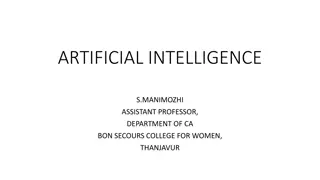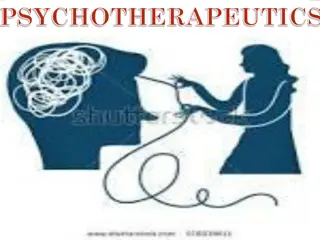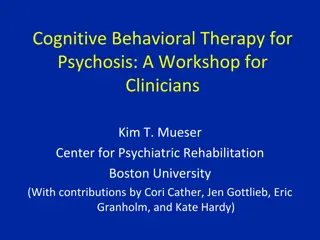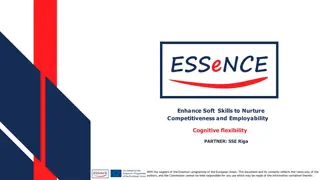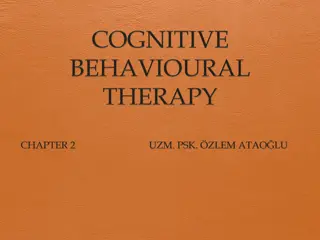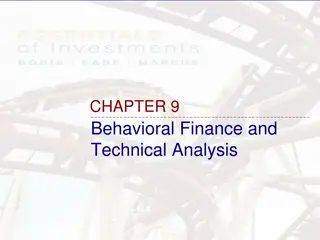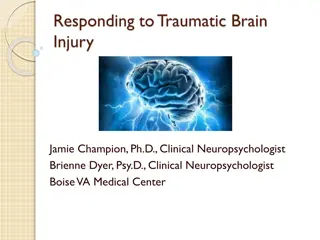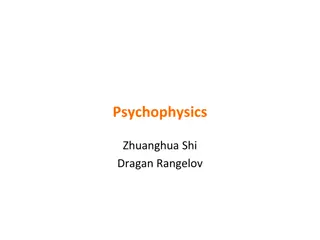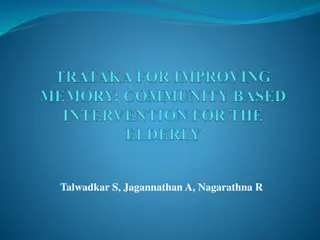Understanding Cognitive Behavioral Approach in Medicine: A Heuristic Perspective
Cognitive-behavioral approach in medicine, analyzed through affective heuristics and problem-solving heuristics, explores factors influencing decision-making processes and the dual processes theory. Key concepts include fast emotional reactions, reliance on emotion in judgment, reducing cognitive load using shortcuts, and the impact of expertise on decision systems. The dual processes theory contrasts experiential and analytic systems, showing how behavior is influenced by rational judgment and previous emotions. The article also highlights anchoring bias in medical and non-medical examples.
Download Presentation

Please find below an Image/Link to download the presentation.
The content on the website is provided AS IS for your information and personal use only. It may not be sold, licensed, or shared on other websites without obtaining consent from the author. Download presentation by click this link. If you encounter any issues during the download, it is possible that the publisher has removed the file from their server.
E N D
Presentation Transcript
Cognitive-behavioral approach in medicine Mgr. Barbora K a Podzim 2020 PP LF MU
Affective heuristic Occurence: Open-ended questions, no intense attention is needed Current mood: highly affects reasoning Affective heuristic: relying on emotion concerning object in fast judgement H: People concentrate their attention less on losess than gains when they are in a good mood Quick emotional reactions (concern or safety?) can serve as relevant information (affect as information mechanism).
Heuristics problem-solving method shortcuts to produce good-enough solutions quick decisions, particularly when working with complex data derived from previous experiences with similar problems using readily accessible, though loosely applicable, information problem solving For example, pattern recognition: seeing a patient with grandiose delusions and pressured speech leading to a rapid differential with the most-likely diagnosis being bipolar disorder. + Advantage Reduce cognitive load: time and effort to make reasonably good judgments and decisions. - Disadvantage: Potential to lead to systematic cognitive errors called biases. Acad Med. 2011 Mar;86(3):307-13.
Factors influencing which system is employed Task complexity S1 typical signs and symptoms S2 atypical symptoms, complex cases Expertise S2 novices, students accuracy of systems 2 thinking depends on knowledge base, expertise..
Dual processes theory Experiential system (intuitive 1) Analytic system (2) Holistic Effortful Emotional: Pleasure Pain Logical: resoning oriented (what is rational?) Associative connections Logical connections Behavior is influenced by rational judgement of events Behavior is influenced by previous emotions Reality is encoded in images, metaphores and narratives Reality is encoded in abstract symbols, words and numbers Fast processing: focues on immediate action Slow processing: focused on postponed action Valid for own person: experiencing is believing Demands support wit logic and evidence
Heuristic or Bias Medical Example Non-medical example Anchoringis the tendency to lock onto salient features in the patient s initial presentation and failing to adjust this initial impression in the light of later information. A patient is admitted from the emergency department with a diagnosis of heart failure. The hospitalists who are taking care of the patient do not pay adequate attention to new findings that suggest another diagnosis. We buy a new car based on excellent reviews and tend to ignore or downplay negative features that are noticed. Affectivebias refers to the various ways that our emotions, feelings, and biases affect judgment. New complaints from patients known to be frequent flyers in the emergency department are not taken seriously. We may have the belief that people who are poorly dressed are not articulate or intelligent. Availability bias refers to our tendency to more easily recall things that we have seen recently or things that are common or that impressed us. A clinician who just recently read an article on the pain from aortic aneurysm dissection may tend toward diagnosing it in the next few patients he sees who present with nonspecific abdominal pain, even though aortic dissections are rare. Because of a recent news story on a tourist kidnapping in Country A, we change the destination we have chosen for our vacation to Country B.
Heuristic or Bias Medical Example Non-medical example Contexterrorsreflect instances where we misinterpret the situation, leading to an erroneous conclusion. We tend to interpret that a patient presenting with abdominal pain has a problem involving the gastrointestinal tract, when it may be something else entirely: for example, an endocrine, neurologic or vascular problem. We see a work colleague picking up two kids from an elementary school and assume he or she has children, when they are instead picking up someone else s children. Search satisficing, also known as prematureclosure, is the tendency to accept the first answer that comes along that explains the facts at hand, without considering whether there might be a different or better solution. The emergency department clinician seeing a patient with recent onset of low back pain immediately settles on a diagnosis of lumbar disc disease without considering other possibilities in the differential diagnosis. We want a plane ticket that costs no more than $1,000 and has no more than one connection. We perform an online search and purchase the first ticket that meets these criteria without looking to see if there is a cheaper flight or one with no connections.
Working memory and affective heuristic You hold in memory 7 digit number and need to write it down in different room On the corridor, someone from your family stops you and asks: Are you going to have chocolate or fruit? You need to rememer the numbers but are hungry too. What are you going to choose?
Working memory and affective heuristic 63% chose chocolate cake when holding in memory 7 digits 41% chose chocolate cake when holding in memory 2 digits Fast judgement of object according to emotion. Capacity of working memory can influence you capacity for reasoning and consider rational arguments.
Historical background of learning theories affective nature of human beings has long been considered secondary and inferior to the study of rational thinking, nonscientific cognitive shift (1960s) psychology was directed even more on cold, afectless mental processes since 1980s mood plays central role in how information about world is represented and affect determines cognitive representation of social experiences Forgas, J. P., & Koch, A. S. (2013). 11
Early evidence linking Mood and Cognition Classical conditioning: if neutral stimulus associates with negative stimulus: child encounters live rabbit + noise negative evaluation of neutral stimulus avoidance of neutral: the child avoids the rabbit(Watson, 1929) https://www.youtube.com/watch?v=V09FuazW8bc People evaluated sociopolitical messages more favorably when in good rather than in a bad mood, induced either by a free lunch (!) or aversive smells, respectively (Razran, 1940) Electric shocks induced negative affect in subjects. Fearful subjects evaluations of another person were more negative than neutral subjects and even greater when subjects were trying to suppress their fear (Wegner, 1994). suppression of fear facilitates the tendency to project fear onto another social object (p. 286) 12
Learning Learning: : Operant conditioning Operant conditioning, is a method of learning that employs rewards and punishments for behavior. Through operant conditioning, an association is made between a behavior and a consequence P, of behavior to repeat depends on consequences stimulus reaction consequence
Cofnitive Cofnitive factors factors in in learning learning Not stimulus provokes behavior, but the meaning it has for a person Behavior can be predicted and understood based on cognitive processes stimulus organism reaction consequence Eye contact with attracitve man Organism: THOUGTHS: I look silly! EMOTION: anxiety BODY: redness in face Reaction: turning away eye contact Consequence: relief from anxiety Eye contact with attracitve man Organism: T: I like him, I want to look good! E: excitement T: pupil enlargement Reaction: smile, long eye contact Consequence: pleasant arousal
Cognitive Cognitive factors ABC Albert Ellis factors when whenresponse response is is formed formed Situation Cognition Consequence: emotion, behavior
Beliefs Rationality Type Description Example Primary Irrational Rigid and extreme demand Assertion of preference transmittedinto a demand I want to be successful and therefore I must Flexible and non- extreme preference I want to be successful but that does not mean I have to be Rational Assertion of preference and negation of demand Athlete believes that if x happens: nothing could be worse, x is worse than 100% bad, and no good could possibly come from this bad event Secondary Irrational Awfulizing I must succeed and if I don't it will be awful Athlete believes that, in face of a struggle to put up with adversity: I will die if the discomfort continues, and I will lose the capacity to experience happiness if the discomfort continues Low frustration tolerance I must succeed and it is unbearable to fail When I fail, it means that I am an idiot When they treat me poorly, it proves they are bad people Self-/other-downing Self and others are rated on the basis of one aspect Athlete believes that if x happens: worse things could happen, x is not more than 100% bad, and some good could possibly come from this bad event I want to succeed but if I don't it will not be awful Rational Anti-awfulizing Athlete believes that, in face of a struggle to put up with adversity: I will not die if the discomfort continues, and I will not lose the capacity to experience happiness if the discomfort continues I want to succeed but failure is not unbearable High frustrationtolerance When I fail, it is bad, but does not mean that I am an idiot When they treat me poorly it is bad, but does not prove they are bad people Self and others are not rated on the basis of one aspect. It is unconditionally accepted that self and others are fallible, unique, and un-rateable Self-/other-acceptance
Experience Experience of of patient patient Part of human psychology in awareness: emotion, cognition a behavior Thoughts hypotheses which can be confirmed or not, not facts Emotion validate that there are no good or bad feelings, labeling helps to deal and act in constructive ways Behavior strengthen: valued behavior condition with positive consequences
Cognitive Cognitive behavioral behavioral interview interview When too ambiguos or technical What exactly do you mean? Reflective feedback: to make sure you understand Don t use suggestive questions ( You were probably scared, right? better: How did you feel in that situation? ) Open ended more specific questions Avoid starting with Why... (asking for explanation), better: Who? , Where? , How often? (asking for description) Assure the patient that his problems are common Strong emotion be patient, curious, compassionate (What does it mean for the patient? Why is he/she so upset?)
Problem Problemdescription description Subjective description of symptoms, their evolution, triggers, consequences, related problems ... Looking for mechanisms that maintain problem behavior Predisposing factors Precipital factors internal / external
Microanalysis of problematic behavior Situation Cognition Modifying factors Emotion Bodily signals Behavior Consequence
Microanalysis of problematic behavior SYMPTOMS Eg. Increased heart rate palpitations (Mis)interpretation It mus be a heart attack Emotion Increased anxiety Increased symptoms
Consequences Consequences Relationships, work, reputation, health.... Short-term positive / negative Long-term positive / negative
Goal Goal setting setting to to motivate motivate the the patient patient What do you want to happen at the end of your treatment? S: specific M: measurable A: attainable R: relevant T: timely
Mylienky How to know patients thouths What do you think? What is going to happen? What if you will never change how you think? What is the worst case scenario? Hot + emotion / Cold descriptive
Useful CBT techniques
Thougts.... Trigger (situation) Behavior Emotions Bodily signals... Consequences Short-term positive.... Short-term negative... Long-term negative..... Long-term positive....
Cognitive restructuring 1. Situation When? Where? Who? What? 2. Emotion Intesity 1-10 3. Automatic thought Persuasiveness 0 100% 4. Evidence proving thought 5. Evidence against thought 6. Alternative thought Persuasiveness 0-100% 7. Emotion now Intensity 1-10
Thank you for attention Suggested study materials: Croskerry P. (2002). Achieving quality in clinical decision making: cognitive strategies and detection of bias. Academic emergency medicine : official journal of the Society for Academic Emergency Medicine, 9(11), 1184 1204. Howard, J. (2018). Cognitive Errors and Diagnostic Mistakes. Springer Berlin Heidelberg. Mandatory study materials: Chapters from Psychology in medicine



